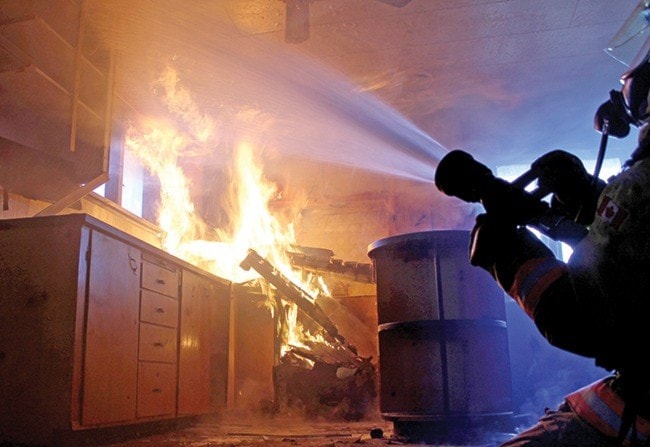Chief Troy Bater sent me into the burning building with George Klemm, a man with 40 years experience fighting fires and for that, I was grateful.
They named a fire hall in Errington after the guy, so I figured I was in good hands.
The Errington Volunteer Fire Department gained some valuable experience Sunday when they were able to burn, and extinguish, a house donated to them by a family who planned to demolish the structure.
Bater decided to offer this reporter a chance to see what it's like to fight a structure fire and to see how fire reacts and spreads. A number of volunteers had to take time away from their training to put me in gear and explain how it all worked. I retained some of it.
Thankfully, Klemm was not only patient with this interloper, he was descriptive and got me up close and personal with flames and thick smoke. He explained everything in detail while keeping me in grabbing distance, regardless of whether we were standing in a smoke-filled room or laying on our sides looking up at fire licking the ceiling.
Before I went inside, volunteer firefighters Penny Portman and Chris Bergen got me all geared up. It's many pounds of jacket, pants, boots, tank, helmet and mask.
And they all have clasps and hooks and straps. Portman and Bergen were very patient.
Next came the sobering talk from deputy chief Brad Knorr.
He went over everything that could go wrong and how I should react. This was stuff I soaked in deeply — I mean, a guy should listen carefully to life-and-death info, one would think.
It was time to go inside and Klemm was my man. He led me through the structure, getting me to my knees and side when it was appropriate and giving me a front-row seat to how a fire is fought and how structures can be ventilated of smoke. It was fascinating stuff. And I was having no trouble with the breathing apparatus, which was a relief, both to me and Klemm.
After roughly 15 minutes, it was time to exit the structure. The volunteers continued burning different sections of the structure for the rest of the day, but I thought it best to get out of their way.
I learned some vital, interesting things from Knorr, before and after I went in with Klemm. First, this exercise was not something firefighters will see for real, in all likelihood. Knorr explained that because of oil-based carpets and other structural changes, firefighters rarely if ever enter a burning building. Those days, glamourized by Hollywood pictures like Backdraft, are over, for common sense and safety reasons.
Knorr said the message now is all about prevention and smoke detectors because if your house is on fire you’re going to have to get yourself out. Firefighters may try to save a house if they determine they can keep a blaze contained to one room, but they likely will stay outside to ensure the fire does not do damage to other structures in the area.
Out thanks to the Chief Bater, Klemm, Knorr, Portman, Bergen and all the volunteer firefighters of Errington for providing this writer, and our readers, with an inside look at their important duties.
